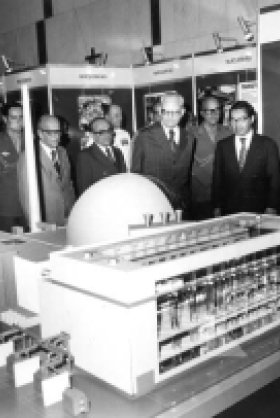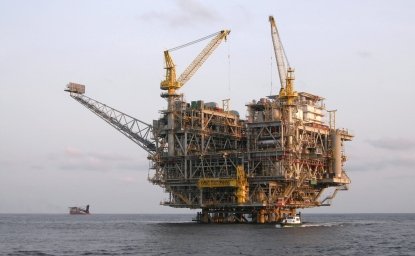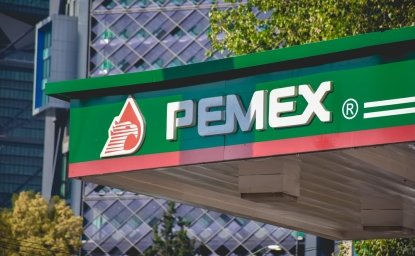Origins and Evolution of the Brazilian Nuclear Program (1947-2011)



The quest to develop an indigenous and fully independent nuclear program has long been an ambition of Brazilian political, scientific, economic and military officials. This research update will sketch the evolution of the Brazilian nuclear program from the first proposal presented to the government in 1947, through the decision to establish a secret civilian-military program in 1978, until the inauguration of the shipyard for constructing nuclear submarines using indigenously developed Brazilian technology in 2011, with a view towards providing an outline of Brazil’s evolving goals in the nuclear realm.
The Early Stages of Brazil’s Domestic Nuclear Development
Brazil’s involvement in nuclear technology development began during the Manhattan Project, when Brazil supplied the program with uranium ore. The country continued to supply the United States with uranium until the mid-1950s when the Brazilian government developed the policy of “specific compensation.” No longer content to provide the raw materials for other countries’ nuclear development, this new policy required that each export of strategic minerals from Brazil correspond to a reciprocal transfer of technology that would help develop the country’s nuclear sector.
The policy of specific compensation was but one manifestation of a widely-shared desire on the part of Brazilian officialdom to acquire for Brazil the same nuclear technologies possessed by the great powers. Admiral Alvaro Alberto, a pioneer of nuclear energy in Brazil and chief advocate of this principle, viewed uranium mining and fuel supply manufacturing for as-yet un-built nuclear power reactors as the first steps towards this goal. As early as 1947, Alberto—who had been representing Brazil at the UN Atomic Energy Commission—presented the first proposal on Brazilian nuclear development to the Brazilian National Security Council (CSN) [Document 1]. Several members of the CSN enthusiastically approved the proposals and even considered the possibility of utilizing nuclear energy as an instrument for “future generations.” Perhaps under pressure from the United States, President Eurico Gaspar Dutra postponed implementation of the plan until the final phase of his government, in January 1951, when the National Research Council (CNPq) was founded under the direction of Alvaro Alberto. One of the main goals of the Council was to coordinate the domestic development of nuclear energy.
Image: Alvaro Alberto shaking hands with Andrei Gromyko at the United Nations Atomic Energy Commission (FGV).
The Early Years of International Cooperation and the Brazilian Nuclear Program
Seeking to accelerate Brazil’s nuclear development, in 1952, President Getulio Vargas approved a plan to cooperate with foreign countries to acquire all phases of nuclear energy production, to build power plants and to train nuclear scientists. Despite strong American opposition to the technology transfer, Brazil negotiated the purchase of centrifuges from West Germany, and uranium dioxide and uranium hexafluoride production plants from France and Great Britain.
All these initiatives, except the purchase of centrifuges, failed when the main supporter of the atomic ambitions, Getulio Vargas, committed suicide in August 1954. The new pro-American government headed by Vargas’ vice-President, General Café Filho (1954-1956), deeply changed Brazilian nuclear policy, which now sought cooperation with Washington within the “Atoms for Peace” program. Furthermore, Alvaro Alberto, who disagreed with the new policy, was forced to resign from the chief post at CNPq, after being charged with mismanagement. In 1956, as a result of the conclusions drawn by a Parliamentary Commission of Inquiry on nuclear energy, the Brazilian National Security Council and the new President, Juscelino Kubitschek, adopted a new nuclear energy plan [Document 2]. In this context a National Nuclear Energy Commission (CNEN) was established directly under the oversight of the Presidency of the Republic, and included plans for the future construction of nuclear plants to produce electricity and the development of a cadre of nuclear engineers and power plant technicians.
While Brazil’s plans for the comprehensive development of an indigenous nuclear industry were ambitious, throughout the 1950s and into the first half of the 1960s Brazilian nuclear activities were confined to research. Thanks to the cooperation with the United States under the “Atoms for Peace” program, Brazil obtained its first research reactor in 1957 and managed to build another, the “Argonauta,” in 1962. The “Argonauta” was the third research reactor in Brazil, and the first built almost completely (93%) by a Brazilian firm which adapted a US design to Brazil’s tropical conditions. Despite this important accomplishment by the Brazilian scientific community, Brazil at the time lacked an overall strategy for the creation of a nuclear industry. A deep domestic political crisis between 1961 and 1964 impeded the implementation of the nuclear projects.
The country’s attitude changed radically in 1967 when the government of Marshal Arthur da Costa e Silva, the second President of the military regime installed in 1964, prepared an elaborate plan for the full development of nuclear energy in Brazil and at the same time adopted a policy of firm opposition to the Non-Proliferation Treaty (NPT). Brazil sought to purchase abroad, in a short time span, nuclear plants that would permit the creation of the nucleus of a national atomic industrial park, while in the longer term it needed to acquire all the technologies necessary to master the nuclear fuel production cycle [Document 3]. The program started to achieve results in 1971 when the National Nuclear Energy Commission (CNEN) signed a contract with the American corporation Westinghouse and the United States Atomic Energy Commission (USAEC) for the purchase of a nuclear power plant and the supply of nuclear fuel.
The West German-Brazilian Nuclear Deal
The oil crisis of 1973 and USAEC’s revision of the contracts for the supply of nuclear fuel in July 1974 provoked an acceleration of the Brazilian nuclear and energy plans. Plan 90, prepared in 1974 by the Brazilian national electricity company Eletrobrás called for the construction of 12 nuclear plants by 1990 in order to satisfy the country’s rising energy needs, in the context of a strong economic growth, and to compensate for possible future shortcomings in the hydroelectric sector. President Ernesto Geisel’s government (1974-1979) planned to gradually acquire the full cycle of fuel production technology [Document 4]. This plan, proposed in September 1974, called for the acquisition of dual-use technology such as uranium enrichment and fuel reprocessing, useful for plutonium production.
It is important to observe that, at the time, the Brazilian government planned to acquire these technologies for civilian purposes exclusively, even if in the following years the military was deeply involved in the development of a secret nuclear program. To manage the future national nuclear sector the government created a state corporation, Nuclebras, headed by Paulo Nogueira Batista, the diplomat who since the end of the 1960s had led Brazil in negotiations on nuclear issues.
To circumvent the United States’ reluctance to cooperate in the transfer of dual-use technology and the supply of new nuclear plants, Brazil signed an important agreement with the Federal Republic of Germany after having made diplomatic overtures towards several industrialized countries. It was the largest technology transfer agreement from an industrialized to an industrializing country ever signed.
On 27 June 1975 the Bonn government made a commitment to transfer at least eight reactors and the full nuclear fuel cycle to Brazil under the international safeguards of the International Atomic Energy Agency (IAEA).
During this period there was mounting American political pressure to prevent the Brazilian military regime, seen as a possible proliferator of nuclear weapons, from receiving sensitive technologies. During the negotiation phase, the German government decided to transfer the “jet nozzle” enrichment method, which was still being developed and was not yet certified at the industrial level. The justification given by Bonn for refusing to transfer the more reliable ultracentrifuge enrichment method was that it was owned by the European nuclear fuel consortium URENCO, despite the fact that it had been developed in West Germany. Washington’s restrictive policy, particularly during the beginnings of Jimmy Carter’s presidency (1977-1981), and the financial crisis in Brazil caused a reevaluation of the civilian nuclear program and the renunciation of plans for a plutonium reprocessing plant.
Image: Ultracentrifuge (FGV)
Brazil’s Parallel Military Nuclear Program
At the end of Geisel’s term, the shortcomings of the agreement with Germany, namely Germany’s refusal to transfer components essential for mastering the nuclear fuel cycle, such as the production of uranium hexafluoride (UF6), resulted in the institution of a secret nuclear project under the coordination of CNEN and implemented by the three branches of the Armed Forces. From the original objective of acquiring technology for the production of uranium hexafluoride [Document 5] the program evolved to include research into all phases of energy production and the construction of a miniature reactor for naval propulsion, and the development of nuclear explosives [Document 6]. This secret project, which paralleled the civilian program under Nuclebras, was not linked to international cooperation and was therefore not encumbered by the growing restrictions imposed by the United States and the Nuclear Suppliers Group (NSG), the cartel of countries producing nuclear fuel or technologies.
The parallel program became public after the end of the military regime, in March 1985. It achieved important outcomes. In the early 1980s, Brazil mastered two key-technologies: yellow cake conversion into pure uranium hexafluoride (UF6) gas suitable for use in enrichment operations, thanks to an experimental plant present at the Institute of Nuclear Research (Instituto de Pesquisa Nucleares, IPEN) in São Paulo; and uranium enrichment, through the indigenous development of the ultracentrifuge method by the Brazilian Navy. Only in September 1987 did President José Sarney announce to the country and the international community that Brazil had reached the capacity of autonomously enriching uranium through a nuclear program that had been kept secret for national security reasons. The secret program was dismantled in 1989 when it was integrated with the safeguarded civilian program previously based on cooperation with Germany.
Brazil’s renunciation of nuclear explosive technology and renewed nuclear ambitions
A few months later, in September 1990, the recently elected Brazilian president, Fernando Collor de Melo held a public ceremony to seal the nuclear explosive test shafts built within a Brazilian Air Force base in Serra do Cachimbo in northern Brazil. A few days later, speaking to the United Nations General Assembly, President Collor announced that Brazil would not pursue research into peaceful nuclear explosions, opening the path to Brazil’s full adhesion to the nuclear non-proliferation regimes (which included full-scope IAEA safeguards, and full membership in the Latin American Nuclear-Weapons Free Zone and the NPT).
Brazil’s nuclear program, furthermore, slowed as a result of the economic crisis that affected the country in the 1980s and in the 1990s. The weak economy contributed to the closure of the UF6 conversion plant and the suspension of the construction of the first two power plants (Angra 2 and Angra 3), which were to be the fruit of the 1975 German-Brazilian deal. These setbacks did not indicate that Brazil had completely given up on its long-standing goal of acquiring the nuclear fuel cycle. Brazilian nuclear ambitions were revived in early 2000s. In 2002 the Angra 2 plant was finally inaugurated, and in 2004 the Brazilian nuclear industrial company —Industrias Nucleares Brasileiras (INB) started the construction of an industrial uranium enrichment plant using the technology developed by the Brazilian Navy. These decisions coincided with strong opposition within Brazil to the IAEA’s Additional Protocol which suggested that many in Brazil felt a need to preserve Brazilian industrial secrets. As in the 1970s, Brazil now has an ambitious energy plan (Brazil 2030), which includes the construction of several nuclear power plants across the country and the completion of Angra 3 by 2021. On the military side the Brazilian Navy resumed its nuclear submarine projects. In July 2011 Brazilian President Dilma Rousseff inaugurated a shipyard that is scheduled to deliver Brazil’s first nuclear powered submarine—built with indigenously developed technologies—by 2023.
Documents Released by Fundacao Getulio Vargas:
Document 1 — Alvaro Alberto’s proposal to establish a Brazilian Atomic Energy Program
27 August 1947, Minutes of the Tenth Session of the National Security Council
Source: National Archive (Brasilia).
The minutes describe the internal discussion at the National Security Council of a proposal to establish a nuclear program sent from New York by Admiral Alvaro Alberto, who was representing Brazil at the United Nations Atomic Energy Commission (UNAEC). The Council approved the Admiral’s proposal and one of its members, Colonel Bernardino Corrêa de Matos Netto declared that “it is not convenient that Brazil relinquishes [nuclear energy], because it is necessary to prepare the ground for future generations.”
Document 2 — The Second Brazilian Nuclear Plan
30 August 1956, Minutes of the Twentieth Session of the National Security Council
Source: National Archive (Brasilia)
At this meeting the National Security Council decided to reform the Brazilian nuclear sector by placing it under the direction of CNEN (National Nuclear Energy Commission). The CSN suggested young technicians and academics should be instructed abroad in order to stimulate the development of professionals in that field. One of the objectives of the nuclear policy was the production of nuclear fuel from domestically-sourced minerals. The Brazilian government criticized the monopoly on nuclear fuel by the big powers.
Document 3 — The Brazilian Nuclear Project of Costa e Silva’s government
4 October 1967, Minutes of the Fortieth Session of the National Security Council
Source: National Archive (Brasilia)
This document contains guidelines for the Brazilian nuclear policy in Costa e Silva’s government (1967-1969) and defines the diplomatic attitude of Brazil regarding the negotiations of the Non-Proliferation Treaty (NPT). During the meeting of the National Security Council, participants agreed on the need to cooperate with another country to start a national nuclear program. On the NPT negotiations, the members of the National Security Council agreed to establish a condition to adhere to the Treaty: the defense of the right to develop peaceful nuclear explosions. Several ministers defended the possibility of using nuclear energy in the future for international security reasons.
Documento 4 — The National Development Plan and the Nuclear Program of the Geisel’s Administration
13 August 1974, Exposição de Motivos[1] no. 055/74 from the National Security Council
Source: Centro de Pesquisa e Documentação de História Contemporânea do Brasil (CPDOC), Fundação Getúlio Vargas (FGV), Azeredo da Silveira Archive, AAS1974.o8.15 mre/pn [1/661].
The document outlines the government’s decision to acquire all phases of the cycle of production of nuclear fuel through cooperation with a foreign government, in this case the Federal Republic of Germany. Reference is made to the need to develop uranium enrichment technology in accordance with the 1967 nuclear policy, which had not yet been implemented.
Document 5 — The Start of the Secret Program
18 June 1979, Aviso[2] no. 135/79 from the General Secretariat of the National Security Council
Source: Archive of the Brazilian Ministry of Foreign Affairs (Brasilia).
In 1978 the National Security Council identified the most important shortcoming of nuclear cooperation with Germany: the non-transfer of technology for the production of uranium hexafluoride (UF6). The lack of this crucial phase for the production of nuclear fuel led Brazil to decide to develop this method by national means, in view of the unwillingness of France and Great Britain to export said technology without a full scope of safeguards. The document reports how the government decided to create an autonomous nuclear project with regard to cooperation with Germany and free from the international safeguards regime. Coordinated by CNEN and implemented by the Institute of Energy and Nuclear Research (IPEN), this project represented the first phase of the “parallel” nuclear program whose objective was the autonomous mastery of the nuclear cycle.
Document 6 — The Structure of the Parallel Nuclear Program
21 February 1985, Exposição de Motivos no. 011/85 from the National Security Council.
Source: Private Archives.
This top-secret document describes the secret parallel nuclear—or autonomous—program. The program resulted from the common effort of the three Branches of the Armed Forces—the Army, Navy and Air Force, plus CNEN and IPEN—under the coordination of the National Security Council. The objective was “to develop national competence to create conditions for wide-ranging use of nuclear energy, including naval propulsion and the production of nuclear explosives for peaceful purposes.”
Disclaimer: This dossier is the result of ongoing research on the international history of Brazil’s nuclear program. The above historical narrative and selection of documents and oral history interviews might be updated as new and relevant evidence is uncovered.
[1] Translator’s note: “Exposição de Motivos” is the official designation of a formal written communication addressed to the President of the Republic.
[2] Translator’s Note: “Aviso” is the official designation of a formal written communication from a Cabinet Minister to another authority of the same rank.
Editors Note:
A previous version of this article featured a mis-translation of "guerras futuras" (future generations) as “gerações futuras" (future wars). This error was corrected on February 4th, 2015.
Author


Nuclear Proliferation International History Project
The Nuclear Proliferation International History Project is a global network of individuals and institutions engaged in the study of international nuclear history through archival documents, oral history interviews, and other empirical sources. Read more


Cold War International History Project
The Cold War International History Project supports the full and prompt release of historical materials by governments on all sides of the Cold War. Read more

Explore More
Browse Insights & Analysis
US Diplomatic Efforts Stalled Brazil's Nuclear Program in 1970s

La esencia de la infraestructura global: perspectivas del líder de la industria Matt Harris

